Banana Peel-Derived Bioplastics: A Green Alternative for Sustainable Materials
| Received 30 Aug, 2025 |
Accepted 20 Oct, 2025 |
Published 31 Dec, 2025 |
Background and Objective: Plastic pollution is a critical environmental challenge, endangering ecosystems and human well-being, with current alternatives such as paper lacking the durability and versatility of plastics. This study aimed to develop biodegradable plastic from banana peel waste, addressing the dual need for sustainable materials and effective organic waste management. Materials and Methods: Waste banana peels were collected, washed, dried, and processed into a paste, which was blended with gelatin (binder), glycerin (plasticizer), and vinegar (pH stabilizer). The mixture was subjected to controlled heating to produce biodegradable plastic sheets. The prepared material was evaluated for mechanical strength, water resistance, and biodegradability. The ANOVA revealed statistically significant differences (p<0.05) in degradation rates, confirming that variations in strength, water resistance, and biodegradability were due to the tested variables. Results: The bioplastic demonstrated favorable mechanical stability and moderate water resistance, while showing clear microbial degradation under controlled conditions. Its degradation rate was significantly faster than conventional plastics, with the by-products enriching the soil as organic biomass. Conclusion: Banana peel-derived bioplastics represent a cost-effective, eco-friendly alternative to petroleum-based plastics. While limitations exist in durability compared to synthetic polymers, the approach highlights a sustainable pathway for waste valorization and supports further research into scaling production and improving material properties.
| Copyright © 2025 Alam et al. This is an open-access article distributed under the Creative Commons Attribution License, which permits unrestricted use, distribution, and reproduction in any medium, provided the original work is properly cited. |
INTRODUCTION
Banana (Musa spp.) is one of the most widely cultivated fruits in Bangladesh, contributing significantly to both rural livelihoods and the agricultural economy. According to the Food and Agriculture Organization (FAO)1, Bangladesh produced over 8.16 million metric tons of bananas1. Banana peels, which constitute approximately 30-40% of the fruit’s total weight, are typically discarded as waste after consumption2. But it contains valuable bioactive compounds. Its composition varies depending on the variety and ripeness stage, but in general, banana peels are rich in: 50-60% carbohydrates, mostly cellulose, hemicellulose, lignin, and starch, which give things their structural stability, 6-9% of proteins, 3-8% of lipids, and dietary fiber 30-50%3.
The starch content, which ranges from 15 to 18%, further increases their potential as a base material for bioplastics. These biological elements improve the tensile strength, water resistance, and biodegradability of bioplastics.
Improper disposal of banana peel waste not only leads to environmental concerns such as methane emissions and increased organic load in landfills but also represents a loss of valuable biomass. These peels are rich in natural biopolymers such as cellulose, lignin, and starch, which can serve as the polymer matrix for bioplastic production. It also includes secondary metabolites such as polyphenols, flavonoids, and alkaloids that have antioxidant and antibacterial qualities in addition to cellulose, lignin, and starch. Several studies have shown that banana peels have higher concentrations of phenolic compounds, antioxidant properties, and other bioactives than banana pulp4.
Natural biopolymers derived from renewable biomass sources, known as bioplastics, are increasingly recognized as sustainable alternatives to petroleum-based plastics. Bioplastics are biodegradable, non-toxic, energy-efficient, and capable of enhancing soil fertility after degradation. In contrast to conventional plastics, which can take 5-6 years to decompose in soil, bioplastics can break down within 4-5 months under suitable conditions. Global plastic pollution remains a critical issue, with an estimated 19-23 million tons of plastic waste leaking into aquatic ecosystems annually5. The urgent need to replace synthetic materials with bio-composite materials derived from renewable resources has driven research into plant fiber-based solutions.
In Bangladesh, plastic pollution is an issue, particularly in urban areas like Dhaka and Chattogram, where polythene bags and single-use plastics clog drainage systems, resulting in waterlogging and environmental harm. The government has previously banned plastic bags, but due to their high price and limited availability, there are still few good substitutes. Waste from banana peels, a year-round by-product, provides an inexpensive alternative that can reduce dependency on plastic while opening up new opportunities for rural businesses.
Banana peel-based bioplastics offer a promising, low-cost, and eco-friendly solution to this problem. In bioplastic production, glycerol is often used as a plasticizer to reduce brittleness and improve flexibility by decreasing hydrogen bonding between starch molecules. Vinegar is added to regulate pH and aid in breaking down peel fibers more efficiently, while gelatin serves as a biopolymer binder to enhance the material’s structural integrity. The composition and unique properties of banana peels position them as a viable raw material for producing biodegradable plastics that are both mechanically robust and environmentally beneficial. One important advantage of bioplastics derived from banana peels is their ability to decompose rapidly in the environment. As they decompose, they return minerals like potassium and phosphorus to the soil, increasing soil fertility and supporting sustainable agriculture.
By transforming banana peel waste into value-added bioplastics, this approach not only addresses plastic pollution but also contributes to the circular economy and sustainable innovation in waste management, as opposed to polymers derived from petroleum that persist in the environment for many decades.
The primary objective of this study was to develop biodegradable plastic from banana peel waste as a sustainable alternative to conventional plastics. Specifically, the study aimed to (i) Analyze the proximate composition of banana peels to evaluate their suitability as a raw material, (ii) Formulate bioplastic sheets using natural additives such as gelatin, glycerin, and vinegar, and (iii) Assess the resulting material for mechanical strength, water resistance, and biodegradability in comparison with conventional plastics.
MATERIALS AND METHODS
Study area and duration: The study was conducted from March, 2025 to May, 2025, in the Department of Biochemistry and Biotechnology, University of Science and Technology Chittagong (USTC) Laboratory. The banana samples were collected from the local markets of the Chattogram Region for this study.
Collection of the sample: Locally available bananas were collected from the markets in the Chattogram Region, the pulps were removed, and their peels were further used for plastic preparation. Figure 1 illustrates the type of banana and the peels used in this study, and the proximate composition of a banana peel is presented in Table 1, banana peel content (IJIRSET)3.
Sample preparation: The fresh banana peels were spread out on various trays for drying at room temperature for 4-5 min after being cleaned under running distilled water to remove dirt and other residues. After that, the peels were sliced into small pieces using a knife, and then boiled with distilled water for a few minutes, and then dried at room temperature for 30 min. Figure 2, illustrates the small pieces of banana peels sliced for boiling and blending purposes.
Preparation of banana peel slurry: Banana peels were blended with a small amount of water to form a smooth puree, which was subsequently strained to obtain a clear extract, removing any residual solid particles. Figure 3 shows the stepwise preparation of biodegradable plastic film from banana peels.
Preparation of banana peel-based bioplastic film: The banana peel extract was combined with gelatin powder in a mixing bowl at a ratio of 2 parts extract to 1 part gelatin. Specifically, 120 mL of banana peel extract was mixed with 60 g of gelatin powder until a uniform solution was obtained.
| Table 1: | Banana peel content | |||
| Item | Proximate composition |
| Starch | 50-60% |
| Protein | 8.6±0.1% |
| Fat | 8.40 (g/100 g)±0.2 |
| Starch | 12.78±0.9 |
| Ash | 15.25±0.1 |
| Total dietary fat | 50.25±0.2 |
| Total phenolic content | 7.40% |
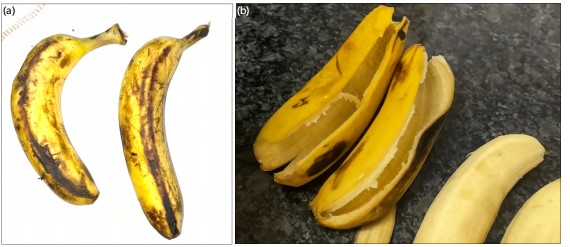
|
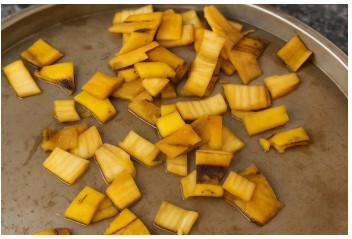
|
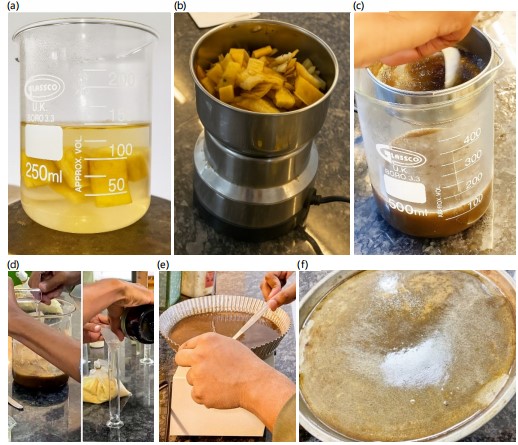
|
Following mixing, 15 mL of vinegar was added to aid in the breakdown of peel fibers, along with 22.5 mL of glycerin (optional) to improve flexibility. The mixture was transferred to a pot and heated over medium heat with continuous stirring to gelatinize the starch and ensure complete integration of the banana peel extract and additives.
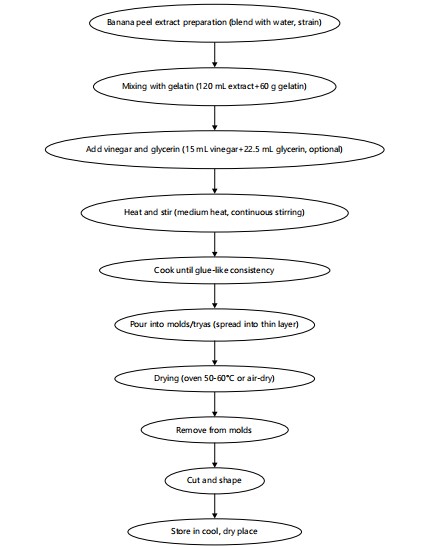
|
Process begins with the collection and cleaning of banana peels, followed by drying and blending into a fine puree. The puree is mixed with plasticizers such as glycerol, glycerin, and vinegar to form a homogenous solution. After heating and casting, the mixture is cooled and dried, resulting in biodegradable plastic films with eco-friendly applications
Heating was continued until the mixture reached a glue-like consistency, ensuring it was smooth and free of lumps. The hot mixture was then poured onto molds or flat trays and evenly spread to form a thin layer. When molds were used, specific shapes could be obtained.
Drying was carried out in a hot-air oven at 50-60°C or in a drying apparatus until the film was completely dry, typically requiring several hours. Alternatively, air-drying at room temperature was possible but required an extended drying time. Once dried, the bioplastic films were carefully removed from the mold or tray, cut into the desired shapes, and trimmed to obtain smooth edges. The prepared films were stored in a cool, dry place until further use.
Figure 4 displays the steps for the production of biodegradable bioplastic using banana peel. The flowchart summarizes the collection and thorough cleaning of banana peels to remove dirt and residues. The peels are then dried and blended into a fine puree, ensuring uniform consistency. This puree is mixed with natural plasticizers such as glycerol, glycerin, and vinegar, which enhance flexibility, durability, and binding properties. The homogenous mixture is heated under controlled conditions to allow proper gelatinization of starch, followed by casting into molds or thin sheets. After cooling and drying, the material solidifies into biodegradable plastic films. These films demonstrate potential eco-friendly applications as sustainable alternatives to conventional plastics, owing to their biodegradability, low cost, and reduced environmental impact.
Comparative characterization of banana peel, gelatin-based, and bioethylene-derived bioplastics
Tensile strength: The ASTM standard machine was used to measure the tensile strength. In the addition of starch, the tensile strength improves, but in its absence, it is minimal.
Biodegradability test: The synthesized bioplastic and other bioplastics were cut into small pieces and placed in three different marked pots containing soil at a depth of 5 cm from the surface. To enhance bacterial enzymatic activity, a certain amount of water was sprayed onto the soil. These samples were stored in the beaker for approximately 18 days, during which time degradation of the bioplastic was observed every 5 days, and the findings were noted6.
Transparency test: A UV-Vis spectrophotometer set to 600 nm was used to measure light transmittance and visually inspect the films’ clarity in order to assess the transparency of the banana peel bioplastic compared with the other bioplastics.
Flexibility test: Flexibility was determined through manual bending and folding tests, as well as by applying tensile strength measurements using a Universal Testing Machine (UTM). Films were cut into strips (10×50 mm) and tested for elongation at break.
Water resistance test: Water resistance was tested by immersing bioplastic film samples in distilled water at room temperature for 24 hrs and recording the degree of swelling and solubility.
Thermal resistance test: Thermal resistance was analyzed by heating gradually from 30°C to above, and observations were recorded.
RESULTS AND DISCUSSION
Formation of biodegradable film: A biodegradable film with a golden color was successfully prepared from banana peels using starch and cellulose, which involved extraction, mixing with gelatin, vinegar, glycerin, and distilled water, homogenization, and molding in a tray. Figure 4 shows the formation of a biodegradable film using banana peel, producing a flexible and durable film. The final product had a smooth texture and was moldable into various shapes before hardening7.
Tensile strength: The biodegradable film made from gelatin and banana peel extract exhibited a low to moderate tensile strength, indicating adequate mechanical resistance for light packaging applications. As depicted in Fig. 5, the film demonstrates good flexibility and transparency, making it suitable for lightweight packaging applications. The smooth surface texture indicates uniform mixing of additives, while its thin layer formation highlights ease of casting and shaping. Such characteristics reflect the potential of banana peel-derived films as an eco-friendly substitute for petroleum-based plastics. In comparison to gelatin-based bioplastic, as mentioned in Table 2, which shows low to moderate tensile strength as suggested by Mali et al.8, and bio-ethylene-based bioplastic has shown higher tensile strength9.
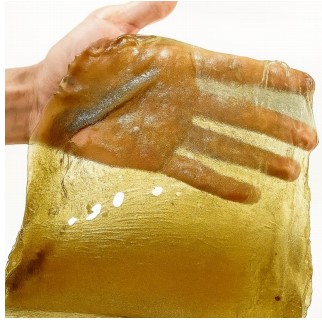
|
| Table 2: | Comparison of the developed bioplastic with other related commercial plastics, highlighting differences in physical and material properties | |||
| Feature | Banana peel bioplastic | Gelatin-based bioplastic | Bio-ethylene-based bioplastic |
| Source material | Banana peel (agricultural waste) | Gelatin (animal collagen protein) | Bio-ethylene (from sugarcane/corn) |
| Type | Starch-based | Protein-based | Polymer-based (like polyethylene) |
| Biodegradability | Highly biodegradable | Highly biodegradable | Less biodegradable |
| Tensile strength | Low to moderate | Low to moderate | High |
| Flexibility | Moderate | High | High |
| Transparency | Opaque or translucent | Transparent to slightly opaque | Clear and Transparent |
| Water resistance | Poor | Poor to moderate | Good |
| Thermal resistance | Low | Low | High |
| Cost of production | Low | Moderate | High |
| Application | Disposable cutlery, packaging | Film wraps, capsules | Bottles, industrial packaging |
| Environmental impact | Very low | Low | Moderate |
| Evaluation demonstrates the biodegradability and eco-friendly potential of the banana peel-based bioplastic while underscoring its limitations compared to conventional plastics | |||
According to these comparisons, banana peel films still have an importance in environmentally friendly packaging, even though their tensile strength may be a little lower than that of some starch-based substitutes. This is especially so considering their reasonable price and potential for waste valorization.
Biodegradability: The prepared biodegradable film from banana peel demonstrated rapid degradation under controlled soil burial conditions, showing visible microbial activity and fragmentation within 2-3 weeks. This degradation rate is significantly faster than conventional gelatin-based plastics, which can persist in the environment for several years. As all the ingredients used are organic and biodegradable, and no harmful chemicals were used in the process, therefore, as mentioned in Table 2, the produced bioplastic film is highly degradable.
Similar results were reported by Jiménez et al.10, who observed that banana peel starch-based films degraded within 120 days under composting conditions, confirming their suitability as an eco-friendly packaging material. In comparison, cassava starch-based bioplastics were reported to degrade completely in 90-100 days8.
These findings confirm that banana peel bioplastic films are comparable to other starch-based biodegradable plastics, offering an environmentally sustainable and low-cost alternative with efficient degradability.
Transparency: The bioplastic films made from extract from banana peels showed a opaque or translucent level of transparency, as shown in Fig. 4. The semi-transparent aspect of the films is a result of the structural elements of banana peel, particularly the starch and pectin. According to Emaga et al.11, light penetration and film clarity are significantly influenced by the starch and fiber content of banana peels.
Flexibility: The banana peel bioplastic film displayed moderate flexibility, which was significantly improved by the addition of glycerin as a plasticizer. Glycerin increases chain mobility and permits films to flex without breaking by decreasing intermolecular hydrogen bonds. Salgado et al.12 showed similar results with bioplastics based on starch and protein.
Water resistance: The hydrophilic nature of the starch caused the films to show poor water absorption. On the other hand, adding vinegar and gelatin decreased solubility in water. Ghanbarzadeh et al.13 observed similar improvements in starch-gelatin-based films with plasticizer reinforcement.
Thermal resistance: Banana peel-based film exhibited low stability under moderate heating but began to soften at higher temperatures due to starch gelatinization. The findings agree with the results reported by Mali et al.8, who noted that starch films are generally limited in their usage in high-heat applications due to their tendency to thermally degrade at high temperatures.
To improve the mechanical and barrier qualities of bioplastics made from banana peels, future studies should concentrate on increasing production quantity and refining formulation parameters. Strength, flexibility, and water resistance may be further enhanced by adding natural fibers or nanomaterials. Life Cycle Assessment (LCA) studies are also required to examine the energy efficiency and environmental impact of large-scale production. The commercial potential could be increased by investigating uses in disposable dishes, agricultural sludge films, and food packaging. Lastly, in order to advance the use of banana peel bioplastics as a competitive substitute for petroleum-based plastics and satisfy global sustainability targets, cooperation between researchers, businesses, and lawmakers will be necessary.
CONCLUSION
This study shows that through the use of natural ingredients like vinegar, glycerin, and gelatin, banana peels,an agricultural waste that is widely available in Bangladesh, can be efficiently used to create biodegradable plastic films. The resultant film exhibited effective biodegradability in a few months under controlled conditions, along with desirable qualities including transparency, flexibility, water resistance, and thermal stability. Banana peel films demonstrated similar tensile strength and rates of breakdown when compared to other starch-based bioplastics, suggesting their promise as an affordable, environmentally responsible substitute for petroleum-based plastics. Additionally, developing them promotes a circular economy and waste valorization. All things considered, bioplastics made from banana peels are a sustainable development that has the potential to greatly lower plastic pollution and improve environmental preservation.
REFERENCES
- FAO, IFAD, UNICEF, WFP and WHO, 2023. The State of Food Security and Nutrition in the World 2023: Urbanization, Agrifood Systems Transformation and Healthy Diets Across the Rural-Urban Continuum. FAO, IFAD, UNICEF, WFP and WHO, Rome, Italy, ISBN-978-92-5-137226-5, Pages: 316.
- Yasin, M., S. Gangan and S.K. Panchal, 2025. Banana peels: A genuine waste or a wonderful opportunity? Appl. Sci., 15.
- Kadam, P. and S. Datta, 2020. Production of biodegradable plastic from banana peel. Int. J. Innovative Res. Sci. Eng. Technol., 9: 6177-6185.
- Sulaiman, S.F., N.A.M. Yusoff, I.M. Eldeen, E.M. Seow, A.A.B. Sajak, Supriatno and K.L. Ooi, 2011. Correlation between total phenolic and mineral contents with antioxidant activity of eight Malaysian bananas (Musa sp.). J. Food Compos. Anal., 24: 1-10.
- Lau, W.W.Y., Y. Shiran, R.M. Bailey, E. Cook and M.R. Stuchtey et al., 2020. Evaluating scenarios toward zero plastic pollution. Science, 369: 1455-1461.
- Yaradoddi, J., V. Patil, S. Ganachari, N. Banapurmath, A. Hunashyal and A. Shettar, 2016. Biodegradable plastic production from fruit waste material and its sustainable use for green applications. Int. J. Pharm. Res. Allied Sci., 5: 56-66.
- Alcivar-Gavilanes, M.G., K.L. Carrillo-Anchundia and M.A. Riera, 2022. Development of a bioplastic from banana peel. Ing. Investigacion, 42.
- Mali, S., M.V.E. Grossmann, M.A. Garcı́a, M.N. Martino and N.E. Zaritzky, 2004. Barrier, mechanical and optical properties of plasticized yam starch films. Carbohydr. Polym., 56: 129-135.
- Verma, P., R. Rani, D. Das, K.K. Rai, P. Gogoi and L.S. Badwaik, 2024. Transformation of banana peel into biodegradable film added with starch and carboxymethyl cellulose and its characterization. Sustainable Chem. Pharm., 37.
- Jiménez, A., M.J. Fabra, P. Talens and A. Chiralt, 2012. Edible and biodegradable starch films: A review. Food Bioprocess Technol., 5: 2058-2076.
- Emaga, T.H., J. Bindelle, R. Agneesens, A. Buldgen, B. Wathelet and M. Paquot, 2011. Ripening influences banana and plantain peels composition and energy content. Trop. Anim. Health Prod., 43: 171-177.
- Salgado, P.R., V.C. Schmidt, S.E.M. Ortiz, A.N. Mauri and J.B. Laurindo, 2008. Biodegradable foams based on cassava starch, sunflower proteins and cellulose fibers obtained by a baking process. J. Food Eng., 85: 435-443.
- Ghanbarzadeh, B., H. Almasi and A.A. Entezami, 2010. Physical properties of edible modified starch/carboxymethyl cellulose films. Innovative Food Sci. Emerg. Technol., 11: 697-702.
How to Cite this paper?
APA-7 Style
Alam,
K.R., Tarabi,
S.M., Guha,
P., Rabbi,
I., Akbar,
G.W. (2025). Banana Peel-Derived Bioplastics: A Green Alternative for Sustainable Materials. Asian Journal of Biological Sciences, 18(4), 914-922. https://doi.org/10.3923/ajbs.2025.914.922
ACS Style
Alam,
K.R.; Tarabi,
S.M.; Guha,
P.; Rabbi,
I.; Akbar,
G.W. Banana Peel-Derived Bioplastics: A Green Alternative for Sustainable Materials. Asian J. Biol. Sci 2025, 18, 914-922. https://doi.org/10.3923/ajbs.2025.914.922
AMA Style
Alam
KR, Tarabi
SM, Guha
P, Rabbi
I, Akbar
GW. Banana Peel-Derived Bioplastics: A Green Alternative for Sustainable Materials. Asian Journal of Biological Sciences. 2025; 18(4): 914-922. https://doi.org/10.3923/ajbs.2025.914.922
Chicago/Turabian Style
Alam, Kazi, Reyashad, Syeda Muntaha Tarabi, Partha Guha, Isma Rabbi, and Gazi Wafa Akbar.
2025. "Banana Peel-Derived Bioplastics: A Green Alternative for Sustainable Materials" Asian Journal of Biological Sciences 18, no. 4: 914-922. https://doi.org/10.3923/ajbs.2025.914.922

This work is licensed under a Creative Commons Attribution 4.0 International License.



